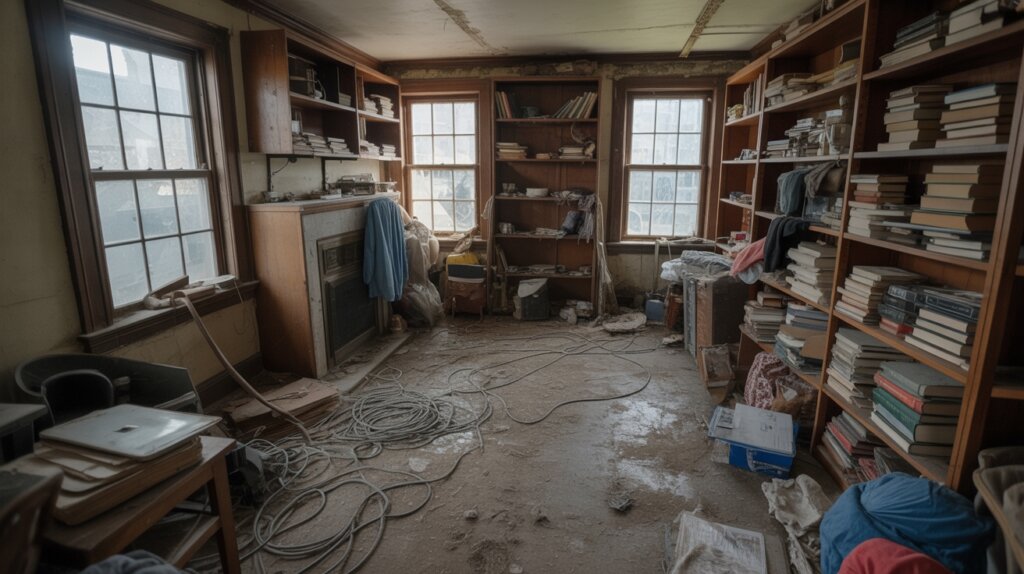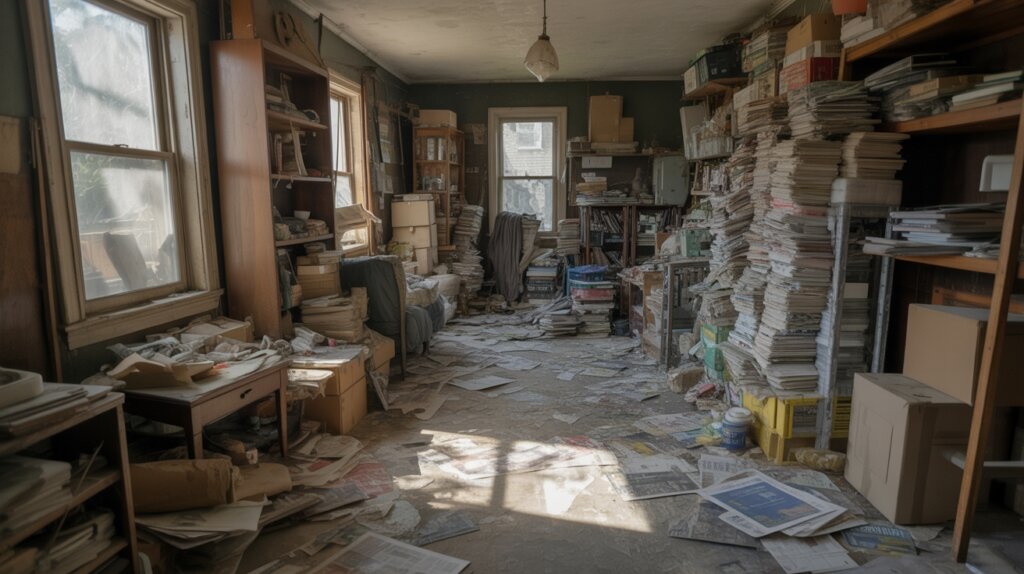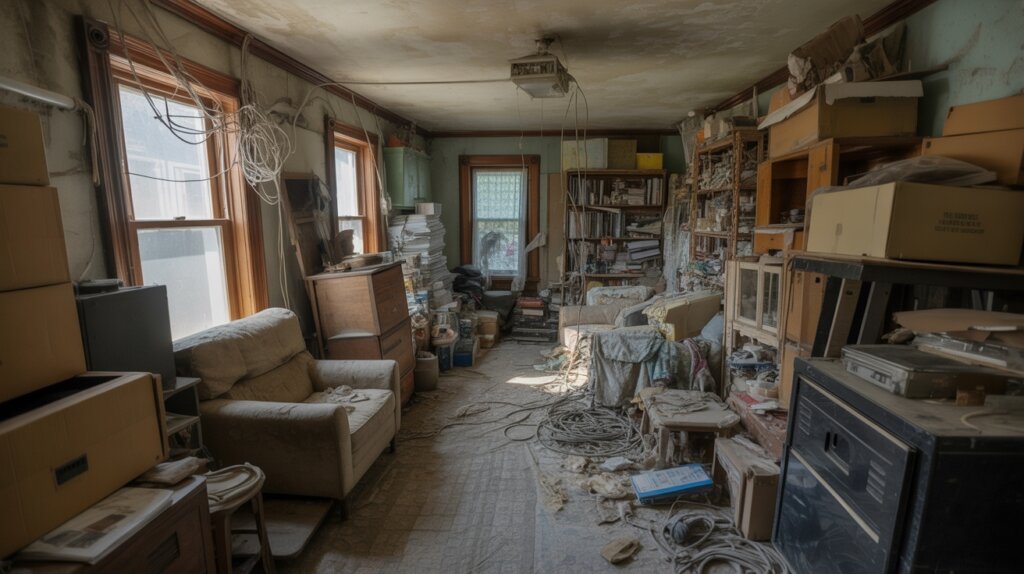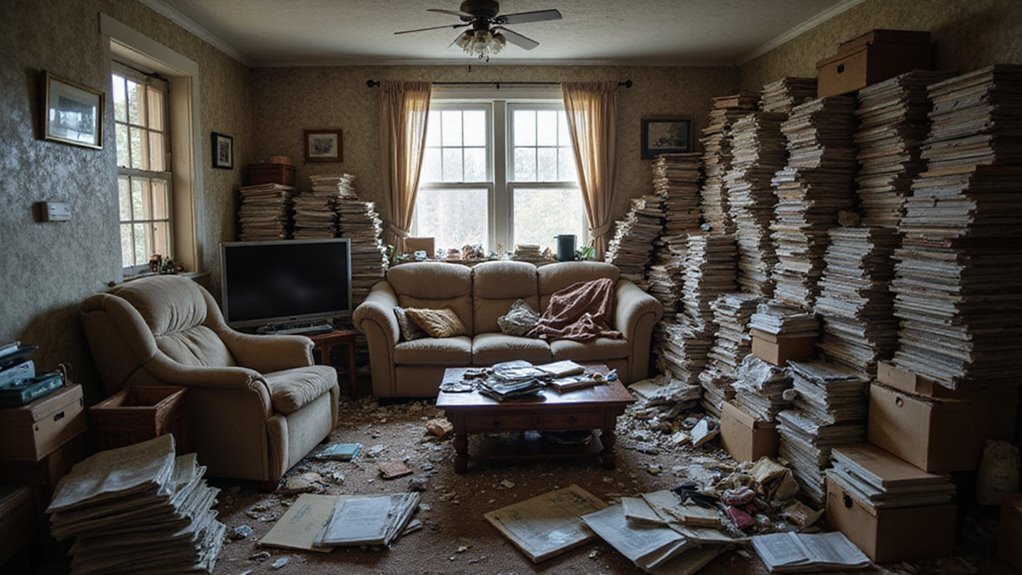Selling a hoarder house brings unique challenges. Clutter, odors, and hidden damage can scare off buyers and lower offers. Many sellers wonder if they should renovate first or sell as-is.
Leaving the house untouched can make it hard to attract buyers. Renovating can be expensive and stressful, especially if the house has severe issues.
The wrong choice could cost you time and money. You should only renovate a hoarder house before selling if the potential profit outweighs the costs and risks.
This blog will walk you through the pros and cons to help you make the best decision for your situation. We will help you understand your options and solve the problem step by step.
Key Takeaways
- Renovating a hoarder house can boost market value and attract more traditional buyers, but costs often exceed 60%–80% of the return.
- Selling as-is may be faster and appeals to investors, especially if renovation costs are high or the local market favors fixer-uppers.
- Major issues like mold, pests, or structural damage should be addressed for safety and to avoid legal or disclosure problems.
- Deep cleaning and decluttering, even without full renovation, can significantly improve appeal and sale price.
- Always compare renovation costs to potential sale price and consult local market data before deciding.
Understanding What Constitutes a Hoarder House

A hoarder house is a home filled with too many items, making normal living difficult. These homes have things stacked in rooms, hallways, and entryways. The clutter often blocks spaces and lowers the home’s value. Addressing the extent of the hoarding problem is essential before attempting renovations, as it guides the scope of decluttering and repairs needed.
Owners might feel attached to their belongings, making it hard to clear the house. If you plan to renovate, you should be sensitive to their feelings. Understanding these issues helps you handle the process with care and practical planning, especially considering how foundation issues can complicate cleanout and repair efforts.
Common Issues Found in Hoarder Homes
Hoarder homes often have problems that make them hard to sell. Common issues include blocked rooms, hidden damage, and bad smells. These problems lower the home’s value and turn away buyers.
Clutter can hide issues like damaged walls or leaking pipes. Most buyers will not consider a home with visible clutter. If sellers clear out clutter, they may get more offers. Additionally, clutter can sometimes prevent proper inspections, leading to overlooked issues that could surface later. Visible clutter turns away buyers and can hide serious problems; removing it is key to attracting more offers.
Odors from mold, pets, or trash are also common in hoarder homes. If these smells are present, buyers may leave quickly. Professional cleaning is often needed to remove strong odors. Proper ventilation can also help improve indoor air quality and make the home more appealing.
Hidden damage such as pest infestations or faulty wiring may be found under piles of belongings. If left unfixed, these can cause safety concerns. Fixing these problems is important for a faster and better sale. Conducting a thorough inspection before listing can identify hidden damage and facilitate necessary repairs.
Additionally, the presence of hazardous materials like asbestos or mold can significantly impact the home’s safety and desirability, making repairs essential before listing. Addressing these hazardous materials not only ensures safety but also helps prevent potential legal issues.
Assessing the Extent of Cleanup Required

Assessing the extent of cleanup needed helps you plan your renovation. Walk through each room and list all clutter and damage. If you find hazards or pests, note them for special attention. Conducting a thorough damage assessment ensures you prioritize repairs effectively. Homes with a lot of mess take longer to prepare for sale. Some rooms, like kitchens and living rooms, make the biggest difference.
Always focus on these spaces first for the best results. If there is much to sort, use temporary storage for items you want to keep. Separate what can be saved from what must go. Additionally, evaluating the window condition can prevent surprises during the selling process. Careful planning will save you time and money when you renovate.
The Impact of Hoarder Conditions on Property Value
Hoarder conditions can lower a property’s value. Buyers and appraisers notice clutter, neglect, and possible damage right away. These issues make homes sell for much less than similar houses.
Health hazards like mold or pests can scare away buyers. Lenders and insurance companies may also be hesitant to get involved. If a property has these risks, fewer people will want to buy it. Properly addressing property condition can significantly improve the home’s appeal and market value.
Clutter makes rooms look smaller and less appealing. People may feel uncomfortable when touring a hoarder home. If you want to sell for a good price, you should fix these problems first. Addressing issues like mold and water damage promptly can also help improve the home’s condition and value.
Costs Associated With Renovating a Hoarder House

Renovating a hoarder house comes with high costs beyond normal home repairs. Cleaning, removing junk, and fixing damage can be expensive. If you plan to renovate, budget for these extra expenses.
Cleaning and junk removal usually costs $1,000 to $5,000. Major repairs and updates can raise total costs to over $25,000. Pest control and hazardous material removal may add more to your budget. Additionally, handling hazardous materials such as mold, asbestos, or lead-based paint can significantly increase expenses and require specialized services.
If you choose cost-effective upgrades, you may attract more buyers. New flooring and fresh paint are popular and affordable options. Eco-friendly materials can appeal to some buyers but may cost more upfront.
You should always compare the renovation costs to the possible selling price. If expenses are too high, you may lose money. Careful planning helps you make a smart financial choice.
Ensuring the property has a clear title before selling can also help streamline the process and avoid legal complications that could delay or hinder the sale.
Pros of Renovating Before Selling
Renovating before selling can increase a hoarder house’s value. Buyers prefer homes that look clean and well-kept. If you update and declutter, your property may attract higher offers.
Simple projects like fresh paint or new flooring can have a big impact. Industry data shows these updates often recover 70-80% of their cost. Modernizing kitchens and bathrooms may help your listing stand out.
Buyers are more likely to see the home’s true potential after renovations. If you fix minor damage, the house looks move-in ready. This can lead to more interest and possibly a higher sale price. Additionally, addressing repairs early and maintaining documentation can facilitate a smoother sale process, and understanding probate requirements can ensure compliance during the sale.
Cons of Renovating Before Selling
You’ll face substantial renovation costs when tackling a hoarder house, and expenses often exceed initial estimates. Even with significant investment, there’s no guarantee you’ll recoup your money in today’s unpredictable real estate market. Before committing, weigh these financial risks carefully against potential returns. Additionally, evaluate whether a long-distance move might be more practical than extensive renovations. Managing the property’s security and maintenance during the renovation process can also add unforeseen expenses and delays, complicating your sale timeline.
High Renovation Costs
Renovating a hoarder house usually costs much more than expected. The reason is that these homes often need major repairs and deep cleaning. Sellers should prepare for high expenses when updating a hoarder house for sale.
If there is mold, asbestos, or pests, removal can cost thousands. Damaged floors and walls may need expensive repairs. Deep cleaning by professionals is also necessary for health and safety.
Adding new closets or shelves can help the house look better, but it adds to the cost. Renovation budgets often go up quickly because of hidden problems. If you plan to renovate, expect your total costs to rise.
Uncertain Market Return
Renovating a house does not guarantee a full return on your investment. Market changes can lower your expected profit. If the market cools, you may not recover your renovation costs.
Home values often shift due to the economy or buyer trends. Even a well-renovated house may lose value if prices in the area drop. National figures show most renovations recoup only 60% to 80% of their cost.
You should review recent sales in your area before starting big projects. Local real estate experts can give helpful advice. If you want to lower your risk, always check the market first.
Evaluating Your Target Buyer: Investors vs. Traditional Buyers
You need to know whether investors or traditional buyers dominate your local market before planning renovations. Investors typically look for properties they can buy below market value and renovate themselves, while homebuyers want move-in ready homes.
Analyzing recent sales data helps you tailor your strategy for maximum return. Additionally, understanding the presence of property liens and how they impact the sale can influence whether you should address repairs or negotiate with cash buyers willing to handle liens.
Understanding Investor Preferences
Investor preferences are important if you want to sell a hoarder house quickly and profitably. Most investors look for homes with strong profit potential and low upfront costs. They usually care more about value than about appearances or staging.
If you want to attract investors, focus on speed, honesty, and smart pricing. Investors prefer homes sold “as-is” at a discount so they can make a profit. They also like flexible closing dates to help them plan renovations.
Minimal staging is better, as investors want to see the property’s real condition. Clear information about any problems saves them time and builds trust. If you meet these needs, you’ll have a better chance of selling to an investor.
Appealing to Homebuyers
Traditional homebuyers are interested in hoarder homes if the price and condition meet their needs. If the property is renovated, it can attract buyers looking for move-in ready options. Renovated homes often sell for more than homes sold as-is.
Investors usually want homes priced low enough to cover repair costs and still make a profit. They care less about cosmetic problems and focus on potential returns. If your area has more investors, it may be better to sell as-is.
If most buyers are traditional homebuyers, consider fixing major issues before selling. Data shows renovated homes can sell for up to 20% more, but only if renovation costs are reasonable. Always check local sales trends to help decide your best approach.
Financing Options for Renovations
Securing the right financing is important for renovating a hoarder house. Renovations often need a lot of money upfront. If you choose the best funding, you can increase your home’s resale value.
Home equity loans let you use the value in your home for low-interest funds. Personal loans are quick and do not need collateral, but may have higher rates. Credit cards can help with small costs, but interest rates are high.
A 203(k) loan is a government-backed option for big repairs. If you need major updates, this loan can be a good choice. Pick the financing that matches your budget and renovation needs.
Legal and Safety Considerations
Legal and safety requirements must be met before renovating a hoarder house. Zoning laws control what kind of renovations you can do. If you ignore these rules, your project may be stopped or lose value.
Renovating a hoarder house requires following legal and safety rules—ignoring zoning laws can halt your project or reduce property value.
Permits are needed for most renovations. Doing work without permits can cause fines or legal problems. Always check with your local building department first.
Hoarder homes often have health risks like mold or pests. Certified experts should inspect for hazards and structural damage. If you skip these steps, you could face costly delays or safety issues.
The National Association of Home Builders says not meeting safety codes can delay a sale by about 60 days. Early action on legal and safety issues saves time and protects your investment. Taking these steps helps you sell your property faster.
How Renovations Affect Marketability
When you renovate a hoarder house, you dramatically boost buyer appeal and widen your potential market. Data shows updated properties sell faster and often command significantly higher sale prices. By investing in strategic improvements, you position your listing for maximum return.
Boosting Buyer Appeal
Renovations can make a hoarder house much more appealing to buyers. Simple updates help buyers picture themselves living in the space. Organized homes tend to sell faster and attract more interest.
If you remove excess clutter, buyers will see a blank canvas for their own belongings. Modern storage solutions can make each room look tidy and spacious. New paint and lighting will brighten the home quickly.
First impressions are important if you want buyers to stop and look. Clean landscaping and a fresh entryway can draw people in. Strategic changes will directly increase buyer interest.
Increasing Sale Price
Targeted renovations can raise your hoarder house’s sale price. If you remove clutter and update features, buyers may pay up to 20% more. Clean and modern homes usually sell faster and for higher prices.
Modern storage solutions help buyers see the home as organized and functional. Updated storage also makes rooms look bigger, which attracts more interest. If you optimize the layout, buyers may offer more money.
Market data shows that homes with open layouts get higher offers. Strategic updates can reduce visual clutter and increase usable space. If you focus on these changes, you can maximize your return.
Alternatives to Full Renovation
If a full renovation is not possible, there are other ways to add value to a hoarder house. You can make the home more appealing without spending a lot. These steps help you attract buyers and raise your sale price.
Deep decluttering is the first step. Remove extra items to show off the space. Clean rooms look larger and more inviting. Clearing out clutter makes rooms feel bigger and more welcoming, helping buyers see the true potential of your space.
Professional cleaning is also important. A thorough cleaning removes odors and stains. Buyers prefer homes that smell clean and fresh.
Basic repairs can make a big difference. Fix leaky faucets and patch any holes. Replace broken fixtures to improve the home’s appearance.
Affordable storage solutions help organize what remains. Install shelves or use bins to create order. Good storage can make small spaces seem bigger.
Working With Real Estate Professionals Experienced in Hoarder Properties
You’ll want to partner with real estate professionals who specialize in hoarder properties, as they use targeted marketing strategies proven to attract the right buyers. These experts understand the legal requirements for disclosure and can help you avoid costly mistakes. Their valuation skills ensure you price the home competitively, maximizing your return in today’s market.
Specialized Marketing Strategies Needed
Selling a former hoarder home needs unique marketing strategies. A real estate agent with experience in this area can help. Specialized marketing attracts serious buyers and can increase the sale price.
Professional staging shows the home’s potential and reduces focus on its past. Digital ads target investors and people who want to renovate. Clear pricing helps buyers understand the home’s value and condition.
High-quality before-and-after photos build trust and show the improvements. If you use these methods, your home can stand out in a busy market. This approach helps address buyer concerns and improves your chances of a good sale.
Navigating Disclosure Requirements
Disclosure laws require you to share all important details about a renovated hoarder home. You must tell buyers about any past or present issues that could affect value or safety. If you hide problems, you risk legal trouble and may lose buyers.
The National Association of Realtors says that hidden issues can stop 11% of deals and cause lawsuits. Real estate agents with experience in hoarder homes can help you with the disclosure process. They will make sure you share all the needed information.
If you are honest about repairs, past infestations, or damage, you protect yourself from future claims. Full disclosure also helps build trust with buyers. This can make your renovated home more appealing in a crowded market.
Valuation Expertise for Hoarder Homes
Hoarder homes can be hard to value, even after full renovations. Past neglect and stigma may still lower appraisals. A real estate expert who knows hoarder homes can help you get a fair price.
The expert can check your home’s value using sales of similar renovated homes. They might suggest adding smart storage to attract buyers. If you follow their advice, your home could look much more appealing.
Proper documentation and clear disclosures can make buyers feel safer. The expert can also recommend appraisers who understand unique situations. With this help, your home stands out in the market.
Key Factors to Help You Decide Your Next Steps
Before you renovate a hoarder house, look at key factors that affect your investment. These factors help you decide your next steps. Making careful choices now can save time and money later.
Check local home prices to see if renovations add real value. If fixed-up homes in your area sell for much more, renovation may be worth it. If not, selling as-is could be smarter.
Research neighborhood home values—renovations pay off only if updated houses nearby are selling for significantly higher prices.
Inspect the property’s structure for serious damage. Major repairs may cost more than you expect. If repairs are too expensive, consider selling without renovating.
Professional cleaning might be needed for safety or appearance. Sometimes, special cleaning is the only way to prepare the house for buyers. Add these costs to your budget if necessary.
Modern storage solutions can make the home look bigger and more organized. Buyers usually like homes with neat storage spaces. If your target market values organization, this could increase your selling price.
Compare recent sales of similar homes nearby. This helps you set realistic expectations for your final price. If you need to sell quickly, remember that renovations can delay your sale but may raise the price.
Use these facts to decide if renovation or selling as-is is best for you. Careful planning leads to a better result.
Conclusion
If you are considering selling a hoarder house, you should carefully weigh your options. Renovating may bring a higher sale price, but it also takes time and money. Selling as-is can be faster and less stressful.
If you want to avoid repairs and lengthy processes, you could sell your house for cash. We buy houses in any condition, so you do not need to clean or renovate. Sellers who choose this route often appreciate the convenience and speed.
If you are ready to sell your hoarder house quickly and easily, contact OC Real Estate today. We can give you a fair cash offer and handle the details. Let us help you move forward with confidence.

